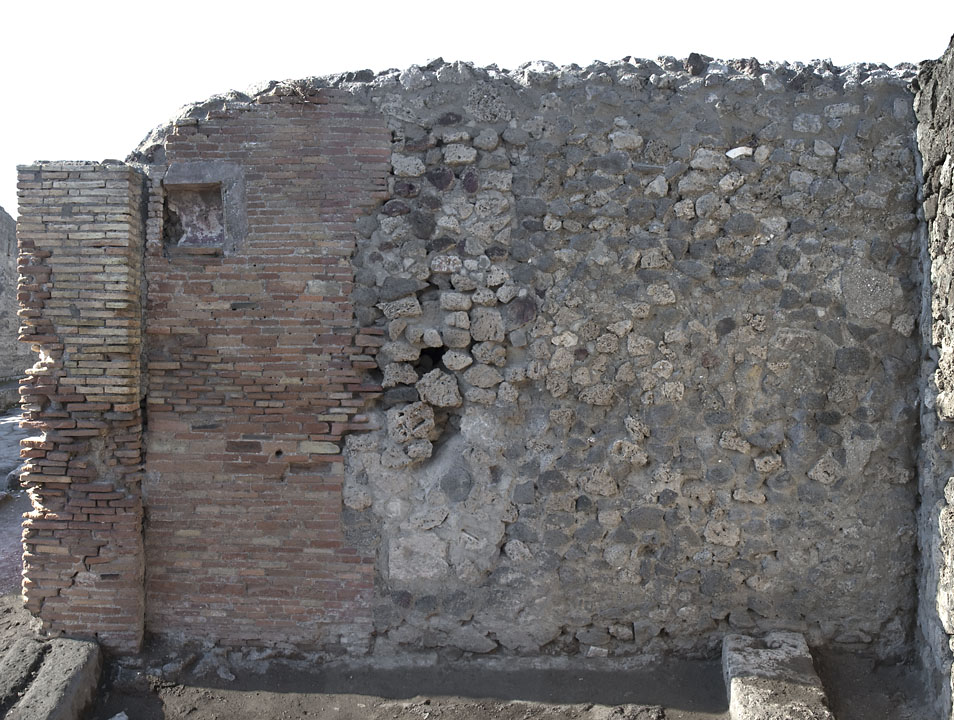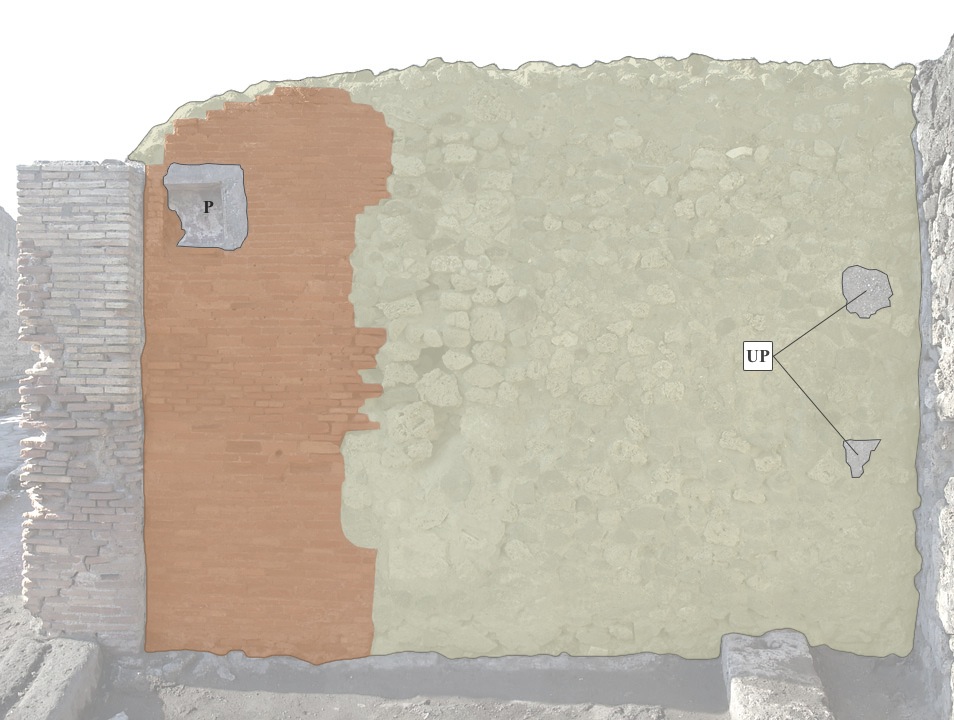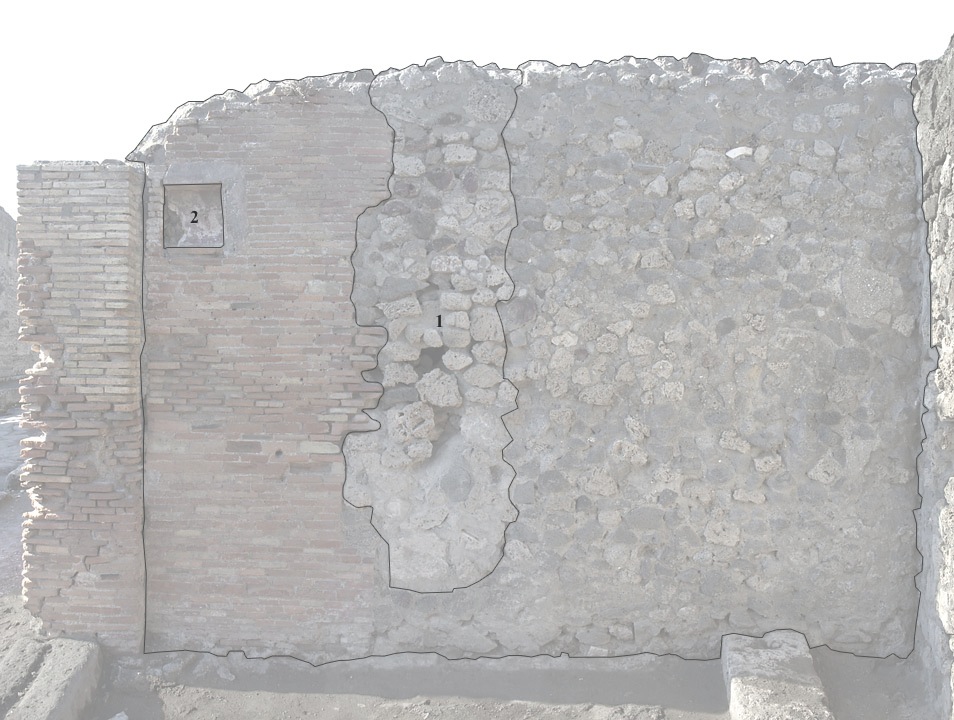North Wall
Description
Mats Holmlund
The wall is approximately 4.05 m wide and 3.25 m high. The main part of it is constructed in opus incertum, while a smaller part, from the west corner until circa 1.20 m into the room, is constructed in opus testaceum. The incertum part of the wall is made up of lava, limestone, cruma, and some random bits of tufa and the testaceum part is built with tiles. The tiles are arranged in a "crenellated" fashion, with circa 0.60 m high and 0.15 m deep "indentations". The tiles vary in size from 0.02 to 0.07 m thick and 0.05 to 0.40 m wide.
There are some features in the wall. The most prominent feature is a niche located in the testaceum part, circa 0.10 m from the west corner and 2.10 m from the floor level. The niche is circa 0.30 m wide and 0.30 m high, and was originally 0.13 m deep. The walls of the niche were covered with red plaster and there was probably a band of green leafy garlands stretching along its "inner walls". On its eastern side the subsurface of the plaster outside the niche is extant and is held in place by modern pinkish mortar. The modern mortar also fixes "the plaster of the roof of the niche". In the lower west corner of the niche the plaster is missing in a 0.10 by 0.25 m large area and the core of the testaceum wall is visible behind it. Although most of the plaster in the niche is extant, it is in such a bad condition that no decoration besides the garland is discernable.
To the right of the testaceum part there is a repaired breach in the wall. The breach is circa 0.85 m wide and 2.70 m high.
There are some spolia in the incertum part of the wall. About eight pieces of harder, stone-like mortar are inserted in the wall at different locations. Except for one of them (that contains a piece of tile) that is located circa 0.70 m from the east corner and 1.80 m from the ground, they are all located in the lower part of the wall. An approximately 0.08 m thick spolia from a coccio pesto floor is located 1.55 m from the west corner and 2.05 m from the floor level. A limestone block is located circa 1.30 m from the east corner and 0.40 m from the floor level. It is circa 0.30 m wide and 0.22 m high. There is also a piece of tufa that probably originates from a wall built in opus reticulatum-style, which is located circa 2.00 m from the west corner and 1.70 m from the ground. Circa 2.65 m from the floor level and 0.90 m from the east corner, there is a piece of travertine in the wall.
There are two holes in the testaceum wall. One is located in the west corner circa 0.85 m from the floor level and is circular in shape with a diameter of 0.10 m. It has (probably quite recently) been filled with mortar. The other one is located 0.70 m from the west corner and circa 1.00 m from the ground. It is circa 0.03 m wide and 0.01 m high.
The mortar of the incertum part of the wall is yellowish grey and contains rather large (circa 0.003 to 0.005 m in diameter in comparison to the more normal 0.001 to 0.003 m) grains of lava and limestone. The same is true for the testaceum part, but there, the grains are somewhat smaller and there are more grains of limestone. Modern mortar seems to have been applied to the wall, at least, at three different occasions. In the middle part of the wall, stretching from the testaceum part to the east corner, between circa 1.40 to 1.90 from the floor level, there is a band of darker grey mortar that contains grains of lava and limestone and bits of lapilli, applied to the wall. Secondly, there is an area at the top of the wall, where modern mortar has been applied along the crest of both parts of the wall in order to prevent the top of the wall from eroding.
The mortar in the testaceum part has eroded away in the same height as the band of recently applied mortar on the incertum part of the wall.
There are three areas where plaster remains on the wall. The first is in the niche. The two other areas are located in the east corner of the wall. The first of them is shaped like a triangle turned upside down and measures circa 0.20 by 0.20 m. It is located circa 0.20 m from the east corner and 1.00 m from the ground. The second one is circular in shape with a diameter of 0.30 m. It is located circa 0.10 m from the east corner and 1.80 m from the floor level. Only the subsurface of the plaster remains in these two last areas.



